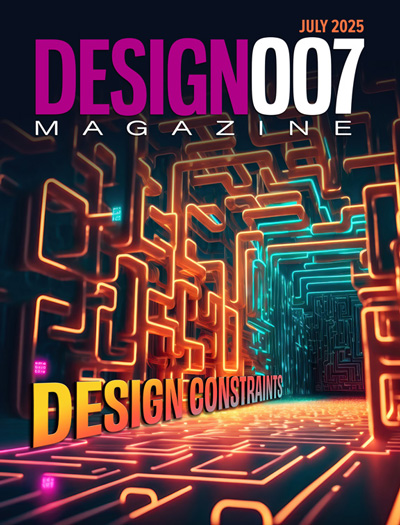-

- News
- Books
Featured Books
- design007 Magazine
Latest Issues
Current Issue
Signal Integrity
If you don’t have signal integrity problems now, you will eventually. This month, our expert contributors share a variety of SI techniques that can help designers avoid ground bounce, crosstalk, parasitic issues, and much more.

Proper Floor Planning
Floor planning decisions can make or break performance, manufacturability, and timelines. This month’s contributors weigh in with their best practices for proper floor planning and specific strategies to get it right.

Showing Some Constraint
A strong design constraint strategy carefully balances a wide range of electrical and manufacturing trade-offs. This month, we explore the key requirements, common challenges, and best practices behind building an effective constraint strategy.
- Articles
- Columns
- Links
- Media kit
||| MENU - design007 Magazine
Cadence Advances Design and Engineering for Europe’s Manufacturers on NVIDIA Industrial AI Cloud
June 13, 2025 | Cadence Design Systems, Inc.Estimated reading time: 2 minutes
At NVIDIA GTC Paris, Cadence announced it is providing optimized solutions for the world’s first industrial AI cloud in collaboration with NVIDIA.
Customers will be able to accelerate the development of their industrial technology by leveraging Cadence’s industry-leading solutions, optimized for NVIDIA Grace Blackwell platforms. These innovative solutions include the Fidelity™ CFD Platform, the Spectre® X Simulator, the Voltus™ IC Power Integrity Solution, and the Innovus™ Implementation System, among others.
Europe’s industrial AI ecosystem will be able to leverage Cadence® solvers accelerated by NVIDIA Blackwell systems by up to 80X from the industrial AI cloud. Ascendance is using Cadence Fidelity computational fluid dynamics software and NVIDIA accelerated computing to design the future of aviation, achieving a 20X reduction in simulation runtimes.
In addition, the AI cloud will be built using the NVIDIA Omniverse Blueprint for AI factory design and operations, which leverages the Cadence Reality™ Digital Twin Platform to simulate and optimize the entire operation in a physically accurate virtual environment, enabling engineering teams to build smarter, more reliable facilities. This approach further ensures performance-driven data center design and drives peak operational efficiency.
“Cadence’s solutions, combined with NVIDIA AI infrastructure, are transforming the future of engineering design for the European ecosystem,” said Michael Jackson, corporate vice president and general manager of the System Design and Analysis Group at Cadence. “By making our solutions available on the NVIDIA industrial AI cloud, we’re empowering Europe’s leaders to design intelligent systems faster and with higher quality than ever before."
“The ability to simulate the physical world with extraordinary fidelity and speed is transforming engineering and design,” said Tim Costa, senior director, CUDA-X and CAE at NVIDIA. “With Cadence tools running on the world’s first industrial AI cloud, Europe’s engineers can invent, test and refine the future before it's built.”
Built on 10,000 NVIDIA Blackwell GPUs in NVIDIA DGX B200 systems and NVIDIA RTX Pro Servers, and running NVIDIA CUDA-X, and NVIDIA Omniverse accelerated workloads, this new AI cloud enables Europe’s industrial leaders to leverage Cadence solutions, accelerating applications for semiconductor and system design end markets, including automotive, energy infrastructure and manufacturing.
Cadence recently announced that it is transforming AI-accelerated simulation for multiple markets, including industrial AI, with its new Cadence Millennium™ M2000 Supercomputer. The Millennium M2000 Supercomputer combines industry-leading design software from Cadence and NVIDIA CUDA-X libraries with the NVIDIA Blackwell platform, including the NVIDIA GB200 NVL72 systems, to accelerate silicon, system and drug design.
Testimonial
"In a year when every marketing dollar mattered, I chose to keep I-Connect007 in our 2025 plan. Their commitment to high-quality, insightful content aligns with Koh Young’s values and helps readers navigate a changing industry. "
Brent Fischthal - Koh YoungSuggested Items
I-Connect007 Launches New Podcast Series on Ultra High Density Interconnect (UHDI)
09/10/2025 | I-Connect007I-Connect007 is excited to announce the debut of its latest podcast series, which shines a spotlight on one of the most important emerging innovations in electronics manufacturing: Ultra-High-Density Interconnect (UHDI). The series kicks off with Episode One, “Ultra HDI: What does it mean to people? Why would they want it?” Host Nolan Johnson is joined by guest expert John Johnson, Director of Quality and Advanced Technology at American Standard Circuits (ASC).
Global Citizenship: Together for a Perfect PCB Solution
09/10/2025 | Tom Yang -- Column: Global CitizenshipIf there’s one thing we’ve learned in the past few decades of electronics evolution, it’s that no region has a monopoly on excellence. Whether it’s materials science breakthroughs in Europe, manufacturing efficiencies in China, or design innovations in Silicon Valley, the PCB industry thrives on collaboration.
The Shaughnessy Report: Winning the Signal Integrity Battle
09/09/2025 | Andy Shaughnessy -- Column: The Shaughnessy ReportWhen I first started covering this industry in 1999, signal integrity was the hip new thing in PCB design. Conference classes on signal integrity were packed to the walls, and an SI article was guaranteed to get a lot of reads.
The Signal Integrity Issue: Design007 Magazine September 2025
09/09/2025 | I-Connect007 Editorial TeamAs the saying goes, “If you don’t have signal integrity problems now, you will eventually.” This month, our experts share a variety of design techniques that can help PCB designers and design engineers achieve signal integrity.
ASC Sunstone Circuits to Exhibit at AEMS 2025
09/09/2025 | American Standard CircuitsASC Sunstone Circuits will be exhibiting at AEMS 2025 (Anaheim Electronics and Manufacturing Show) to be held at the Anaheim Convention Center on September 24 and 25, 2025.


